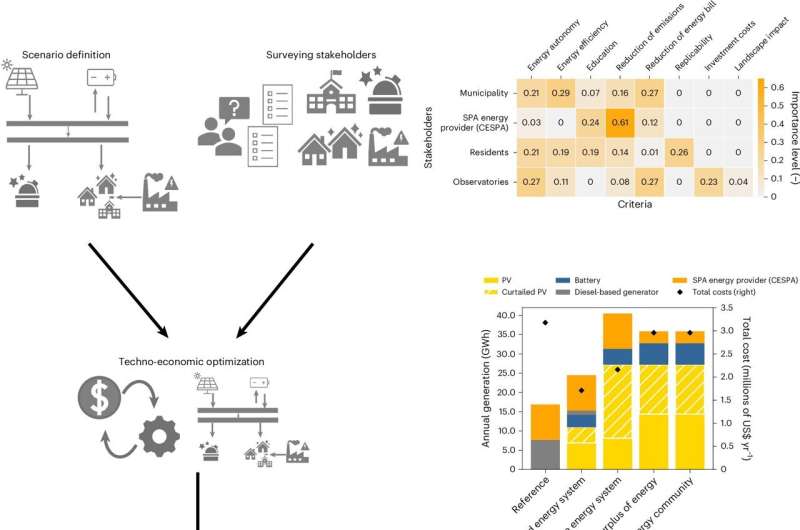Telescopes can help bring renewable energy to isolated Chilean communities
October 11, 2024

Just published research in Nature Sustainability shows that building a renewable energy system for a telescope in Chile’s isolated Atacama Desert could also cover 66% of a nearby community’s energy needs, giving hope for win-win development around other remote infrastructure projects.
Integrating renewable energy sources into the design of the AtLAST telescope would introduce the astronomical community on the Chajnantor plateau and the nearby residential areas to more sustainable energy systems. This integration would reduce local reliance on fossil fuels and provide renewable energy.
The research shows that replicating similar energy systems at nearby telescopes could reduce fossil fuel-based energy generation by 30GWh annually, cutting emissions by 18–24 kilotonnes of carbon dioxide equivalent while contributing to access to affordable renewable energy for surrounding communities.
Home to observatories like the Atacama Pathfinder Experiment (APEX) and the Atacama Large Millimeter/submillimeter Array (ALMA), the Chajnantor plateau in the Atacama Desert, Chile is a global astronomical prime spot. Due to their remoteness, astronomical facilities are often disconnected from the national electricity grid and rely on diesel and gas generators to supply their power-intensive operations.
Atacama Desert a prime location for solar energy
The Atacama Desert is also a prime location for solar energy projects, holding the highest levels of solar irradiation globally. However, although the area hosts 85% of Chile’s solar energy developments, Atacameños pay more for their energy than the capital region. For example, the national electricity grid ends 100km from San Pedro de Atacama, which, besides Patagonia, is one of the most prominent tourist destinations in Chile.
The town and its surrounding areas operated solely diesel and natural gas generators until 2022 and suffer frequent power outages. Most renewable energy generated in the region is used to power lithium mines and exported to other provinces.
The researchers identified the feasibility of using surplus energy from the AtLAST telescope’s energy system to supply San Pedro de Atacama. “A solar renewable energy system sized to supply the telescope could cover 66% of the electricity demand of San Pedro de Atacama without additional capacities in PV or battery,” says co-author Luis Ramirez Camargo, an assistant professor at Utrecht University’s Copernicus Institute of Sustainable Development.
Energy communities
This idea is based on “energy communities,” a union of public, private and commercial entities that jointly invest in or share energy infrastructure or provide energy services, and builds on open and fair decision-making.
The researchers created spaces where local residents and other affected parties could share their take on the challenges and opportunities for a more sustainable energy system in the San Pedro de Atacama area. “Allowing those who are truly affected to participate in the discussion and be able to influence decision-making is essential to arrive at just, locally applicable solutions for the energy transition,” says lead author Guillermo Valenzuela Venegas, a researcher at the University of Oslo.
“Distributing benefits to multiple stakeholders through an energy community can lead to a more socially accepted and just energy transition,” says Ramirez Camargo. “Our research shows that astronomy can lead by example in the urgent transition to an equitable net-zero world, keeping our planet habitable and ensuring no one is left behind.”
More information:
Guillermo Valenzuela-Venegas et al, A renewable and socially accepted energy system for astronomical telescopes, Nature Sustainability (2024). DOI: 10.1038/s41893-024-01442-3
Citation:
Telescopes can help bring renewable energy to isolated Chilean communities (2024, October 11)
retrieved 11 October 2024
from https://techxplore.com/news/2024-10-telescopes-renewable-energy-isolated-chilean.html
This document is subject to copyright. Apart from any fair dealing for the purpose of private study or research, no
part may be reproduced without the written permission. The content is provided for information purposes only.
Search
RECENT PRESS RELEASES
Related Post



